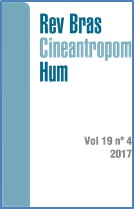Association between obesity, risk of falls and fear of falling in older women
DOI:
https://doi.org/10.1590/1980-0037.2017v19n4p450Abstract
The aim of this cross-sectional study was to investigate the association between obesity, risk of falls and fear of falling in older women. Two hundred and twenty-six volunteers (68.05 ± 6.22 years, 68.06 ± 11.79 kg, 1.56 ± 0.06 m) were classified as normal weight, overweight or obese, according to the body mass index. Risk of falls and fear of falling were evaluated using QuickScreen Clinical Falls Risk Assessment and Falls Efficiency Scale – International (FES-I), respectively. Comparisons between groups were conducted using Chi-square and ANOVA One-way tests. The significance level was set at p< 0.05. Obesity was associated with greater probability of falls (p< 0.001), which may be partly explained by decreased muscle strength (p< 0.001) and reaction time (p< 0.001). In addition, significant differences between groups was observed in FES-I score (p< 0.01), with obese women showing more pronounced fear of falling (30.10 ± 8.4) than normal weigh (25. 33 ± 7.11, p< 0.01) and overweight subjects (26.97 ± 7.05, p< 0.05). These findings corroborate previous evidence pointing obesity as a major risk factor for falls. Therefore, health professionals dealing with fall prevention should consider the effects of overweight.



